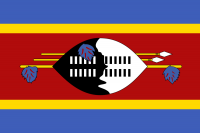Swaziland

The Kingdom of Swaziland is a small, landlocked country covering a total area of 17,364 km² and is located in the southern part of Africa bordered by the Republic of Mozambique to the east and the rest by the Republic of South Africa. Known as the Switzerland of Africa, Swaziland comprises magnificent mountain scenery with unique, ancient rock formations, which are a source of fascination for geologists, scholars and visitors. Within this small area each feature of Africa’s terrain, apart from desert, is to be found. The Kingdom has four topographical and climatic areas ranging from 400 to 1800 metres above sea level, each with its own unique characteristics. The mountainous Highveld to the west features rivers, waterfalls and gorges and has a temperate climate of warm, wet summers and dry winters when the temperature can rise sharply during the day but with cold nights. The subtropical Middleveld, at a lower altitude, is made up of lush, fertile valleys and a warm climate that is ideal for cultivating a diversity of crops and it is here that much of the country’s agricultural activities occur. Further to the east is the Lowveld which is the largest region covering about 40% of the country, and is also subtropical. While this area is drought-prone, sugar cane is successfully grown commercially on a wide scale under irrigation for production of sugar as the country’s major export product. Cattle farming is also extensively carried out here. Much of the area is typically African bush where a wonderful profusion of indigenous wild life, birds and flora are found in protected areas. The smallest region is Lubombo, which borders with Mozambique and it is a subtropical area typified by mountainous scenery and supports abundant plant and animal life. In this region, mixed farming is the main activity carried out.
The 2007 census indicates a population of 1,018,449 people while the 2012 projections indicate 1,080,337 people. About 70% of the population is in rural areas with just 225,293 people residing in the urban areas and about 95.98% of the overall population comprises Swazi nationals. The Manzini and Hhohho regions are the most highly populated with 319,350 and 282,734 people respectively, while Shiselweni and Lubombo are the least populous. Mbabane is the administrative capital of Swaziland while Manzini is another major city and Matsapa the industrial town. The SiSwati and English languages are official languages which are widely spoken in the country while Government combines the western concept of Government with the traditional system and the people elect representatives to Parliament.
The country has one of the world’s smallest economies, relying largely on agriculture. The agricultural sector is the main source of income for more than 70 % of Swazis, particularly in the rural areas. The sector also plays an important role in providing raw materials for the largely agro-based manufacturing industries. Swaziland’s economic situation remains precarious mainly due to significantly reduced revenue from the traditional sources. Forecasts indicate GDP growth of 2% for 2010, however, the GDP is expected to decline in 2011/12 with among other factors, forced reduced government expenditure impacting across the board. Contributing to the slight improvement of 2010 are growth in the agricultural, retail and transport and communications sectors coupled with improved performance by South Africa, the market for more than half of Swaziland’s exports. The main export products are sugar, coca-cola concentrate, cotton, citrus fruits and canned products and maize. The nearest harbour is at Maputo in Mozambique, which is about 235 kilometres from Mbabane, the administrative capital, and 200 kilometres from Matsapha, the country’s main industrial area. It is from here that most of the country’s export products are shipped.
Tourism remains a vital contributor to Swaziland’s economy, and the strong cultural heritage, tradition and biodiversity are strong attractions for tourists. The country has an abundance of features to please visitors, including eight nature reserves with a range of animal and birdlife, spectacular mountain scenery, a rich cultural history and a variety of leisure activities from horseback riding trails and four wheel driving to golfing and fishing. At Malolotja there are well mapped hiking paths, which are an ideal way to view game and Phophonyane, near Piggs Peak is renowned for its diversity of flora. The National Museum, National Archives and King Sobhuza II Memorial at Lobamba, and the Mantenga Cultural Village provide an insight into Swaziland's history and culture.
The cultural heritage is deeply rooted with traditions carefully protected and sustained and colourful ceremonies regularly take place to mark special occasions. The two main rituals are the Umhlanga or Reed dance, and the Incwala or First fruit ceremony. The Umhlanga, which is held during August or September, involves young maidens who, dressed in colourful beaded skirts and accessories, travel to the royal kraal (village) to honour the Queen mother, and perform traditional dances. The Incwala ceremony involves direct participation by the king and everyone is invited as the culmination is in dances at the Royal palace between December and January as it takes place over a three week-period with actual dates selected by astrologers who monitor the moon phases to determine the ideal time.






